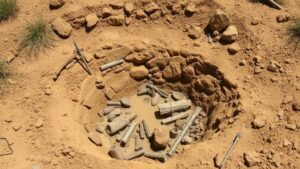Recovering Artifacts Near River Estuaries Where Ships Ran Aground
Recovering Artifacts Near River Estuaries Where Ships Ran Aground
River estuaries, where freshwater from rivers meets the saltwater of the ocean, serve as critical ecological zones and historical hotspots. They are often areas where ships have run aground due to shifting sandbars, navigational errors, or severe weather conditions. The recovery of artifacts in these regions not only enriches our understanding of maritime history but also presents unique challenges and opportunities for archaeologists and conservationists.
The Significance of River Estuaries in Maritime Archaeology
Estuaries are dynamic environments that often preserve artifacts due to their sedimentary nature. mix of freshwater and saltwater can create anaerobic conditions that slow the decay of organic materials, making these locations viable for archaeological exploration. Also, estuaries are historically significant as bustling trade routes and navigational focal points, often revealing details about past civilizations and their interactions.
Challenges in Artifact Recovery
Recovering artifacts from these sites poses various challenges:
- Environmental Conditions: The fluctuating conditions of estuaries, including tidal changes and fluctuating water levels, can hinder recovery efforts.
- Legal and Ethical Considerations: Navigating ownership claims, especially when artifacts hold cultural significance, complicates recovery operations.
- Technical Limitations: Standard recovery techniques may not be applicable in estuarine environments, necessitating specialized equipment and methodologies.
Case Studies of Recovery Efforts
Various notable recovery efforts highlight the complexities and rewards associated with artifact recovery in river estuaries. One significant example is the recovery of the Santa Maria, the flagship of Christopher Columbus. It ran aground in 1492 off the coast of Haiti, and its remains were located in an estuarine area. Excavations revealed numerous artifacts, such as trade goods and navigational tools, which provided insights into early European exploration.
Another example includes the recovery operations at the SS Arctic site in the Delaware River. This 19th-century shipwreck yielded valuable artifacts, including personal effects and ship-building materials, crucial for understanding the maritime commerce of the period. recovery team utilized advanced remote sensing technology, such as sonar and magnetometry, to map the area effectively and avoid disturbances to the ecosystem.
The Recovery Process
The recovery process generally involves several key steps:
- Site Survey: Initial surveys utilize reconnaissance and remote sensing techniques to identify potential sites.
- Permitting and Planning: Gaining necessary permits from local authorities and planning the recovery strategy to minimize environmental impact.
- Excavation: Using specialized tools tailored for submerged recoveries, archaeologists excavate artifacts while carefully documenting their locations.
- Conservation: Post-recovery, artifacts undergo conservation processes to stabilize them for further study and exhibition.
Real-World Applications and Future Directions
The recovery of artifacts from river estuaries informs not only historical scholarship but also present-day maritime practices and conservation efforts. As climate change increasingly affects sea levels and river dynamics, understanding these historical contexts becomes vital. Plus, advances in technology, such as 3D scanning and digital archiving, are revolutionizing how artifacts are studied and conserved, allowing for broader public engagement through virtual exhibits.
Actionable Takeaways
- Collaboration with local communities and stakeholders is essential for successful recovery operations and ensures the safeguarding of cultural heritage.
- Educational programs can raise awareness about maritime history and the importance of artifact preservation.
- Future research should focus on developing environmentally sustainable practices in excavation and conservation methods to mitigate ecological impacts.
In summary, recovering artifacts near river estuaries where ships ran aground is a multifaceted process rich with historical significance. By adopting innovative technologies and fostering community engagement, maritime archaeologists can effectively illuminate the past while preserving it for future generations.

